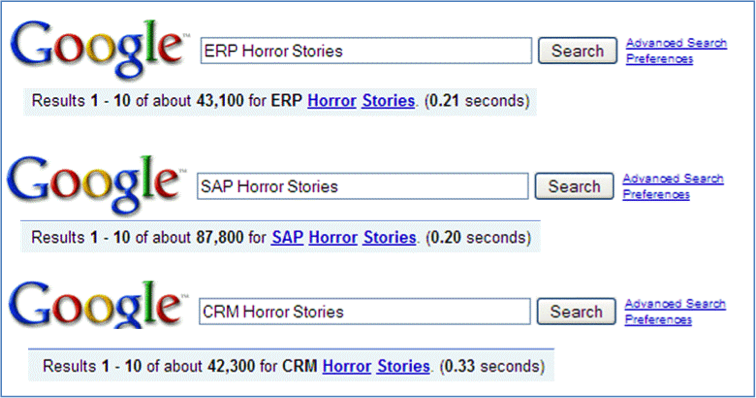10 Step Estimation Process Sample Checklist
View our 10 Step Estimating Process Checklist. This checklist should be tuned to the individual company’s needs and suggestions.

By David DeWitt
Most of us remember the dubious “doctor” in Huckleberry Finn who proclaims to have the cure for any malady. From the back of the crowd his shill would loudly proclaim that he himself had been healed by the magical elixir. Oh my, but the quantity of snake oil they sold before the townsfolk discovered they had been duped – and the doctor long gone. From the tone of many internet blogs it seems the same buyer’s remorse is lingering in the “Packaged Application” world.

Figure 1 – The Ubiquitous Google Search
Before we get into the discussion of packaged applications let’s take a step back and remember how these wonder cures manifested. In the late 1980’s – (when disco was dying) manufacturing companies wanted to shape supply chain management and enterprise resource planning. In short, they wanted to encourage the concept of a “process in a box.” (my quotes). Somehow over the last ten years the industry has forgotten that part about the need for the organizational “process” to change; and as we shall see, that is a key cause of hidden costs.
To belabor the point of “snake oil” for just a moment longer – what exactly is a packaged application?
But it heals the sick and will bring peace and joy to the world … if it’s configured just right!
The top ten hidden costs are – in no specific order:
A colleague recently proposed that he would rate my list with 1, 7, and 10 as his top three issues. He also commented that the metaphor of packaged applications to Snake Oil was appropriate.. I thanked him for his feedback and was feeling quite clever – until I discovered this gem from Scientific America. 3
Chinese water-snake oil contains 20 percent… of the two types of omega-3 fatty acids most readily used by our bodies… Research since the 1980s has demonstrated the necessity—and efficacy—of omega-3 fatty acids. These acids not only reduce inflammation, such as arthritis pain, but also improve cognitive function and reduce blood pressure, cholesterol and even depression.
So perhaps we can survive a little snake oil after all – just beware of the hidden costs.
References cited:
10 Step Estimation Process Sample Checklist
View our 10 Step Estimating Process Checklist. This checklist should be tuned to the individual company’s needs and suggestions.
Estimating Total Cost of Ownership (TCO)
Find out how you can use Total Cost of Ownership (TCO) model to create an estimate which includes all the costs generated over the useful life of a given application.
Should Cost Analysis
Learn how Should-Cost Analysis can identify savings opportunities and drive cost efficiency in procurement and manufacturing processes.
ROM Estimate: The First Step Towards a Detailed Project Plan
Find out what ROM (rough order of magnitude) estimate is and why is it a crucial element of every project planning cycle.
Software Maintenance Cost
Find out why accurate estimation of software maintenance costs is critical to proper project management, and how it can make up to roughly 75% of the TCO.